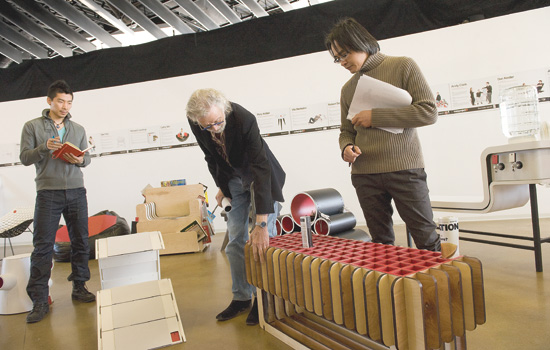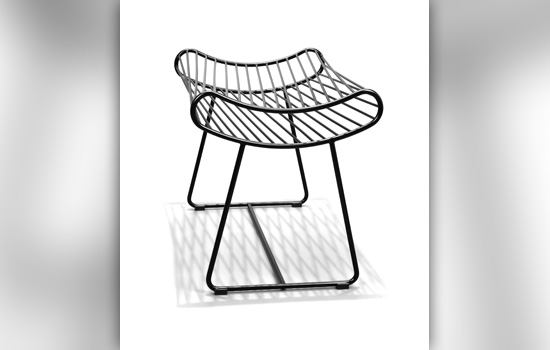A seat at the table
Industrial designers create award-winning chairs offering form and function
Clint Blowers
Dan Fritz, a fourth-year industrial design student, won a design competition sponsored by Wilsonart International. His chair was among those to be on exhibit at the International Contemporary Furniture Fair in New York City.
The “who’s who” in design descends on New York City for Design Week with architects, designers and curators from all over the world seeking the newest contemporary furniture design trends and scouting up-and-coming designers.
Ten RIT industrial design students are among the designers who earned the opportunity to exhibit their chair prototypes at the International Contemporary Furniture Fair, one of the largest furniture tradeshows in the United States that occurs during Design Week, May 13-17.
Among the students is Dan Fritz of Clifton, Va. Fritz won first place in a design competition sponsored by Wilsonart International, a manufacturer of laminate materials. The Wilsonart competition was part of Metaproject, a new course taught and developed by RIT industrial design professor Josh Owen. Over the course of 20 weeks, the students brainstormed ideas for chair prototypes and then designed chairs based on their concepts.
As part of the competition criteria, the seating devices had to be functional prototypes clad in Wilsonart laminate with a sample chip of the company’s logo integrated into the design.
“We used the Vignelli canon as a guide to drive the students’ work, which follows in those modernist footsteps,” says Owen. “The idea was to use seating design as a problem solving activity by looking at social and environmental issues so that each of the seating devices addressed a specific problem.”
A jury of design experts deliberated over the final designs and selected six chair prototypes to be part of the Wilsonart exhibit at the fair.
“It’s such an honor to have my chair selected to be at the ICFF,” says Fritz. “My inspiration for my design came from two chairs in particular, the Womb Chair and the Bertoia Diamond Chair. Both are really inviting, encompassing forms.”
Colleen MacKenzie, a fourth-year industrial design student from Weedsport, N.Y., took second place. MacKenzie’s design, Stanchion, looks like a ladder at first glance, but then upon closer examination it offers a seat.
Andy Clark, a native of Saranac Lake, N.Y., one of four runners-up, developed a laminate bench and then retrofitted a working water cooler into his design to play off the idea of the water cooler conversations at the workplace.
“I was impressed with the quality, the craftsmanship and the inventiveness of the students,” says Belinda Lanks, managing editor of Metropolis magazine and a member of the jury. “I felt like the winners showed an amazing amount of maturity and design sense.”
Graduate students in the industrial design program who produced chairs while studying at the Danish Institute for Study Abroad were also selected to exhibit at the international trade show. The institute selected 12 chairs to display in New York City from about 100 submissions from students attending top design schools. RIT captured four of the 12 spots. The seven-week summer study abroad program includes design lecture classes; a workshop in Copenhagen, Denmark; and visits to famous design museums, design firms and companies in Helsinki, Finland, and Stockholm, Sweden.
“I met many students from different design schools and it was a good opportunity to share school experiences and debate design issues,” says Hong Ying Guo, a second-year graduate student from Pingtung City, Taiwan. “The Danish Institute Study Abroad furniture design program not only provided an environment for students to design their own chairs, but offered me a chance to observe a distinction between different cultural values, design trends and lifestyles, which benefited my design vision.”
Guo’s chair uses steel rods with round edges to allow people to sit comfortably. The empty space between the first and second layers provides room to store magazines or newspapers.
“All of the student work is outstanding,” adds Stan Rickel, chair of RIT’s industrial design program. “The furniture fair is a global venue for them to exhibit, with tens of thousands of visitors attending. It’s a once-in-a-lifetime opportunity for these students to network and get their names and designs out there.”
 Graduate teaching assistant Jae Ho Seo, left, looks on as Wendell Castle, center, RIT artist-in-residence and furniture designer, and Ron Labaco, senior curator of the Museum of Arts and Design, judge the chair prototypes. A. Sue Weisler
Graduate teaching assistant Jae Ho Seo, left, looks on as Wendell Castle, center, RIT artist-in-residence and furniture designer, and Ron Labaco, senior curator of the Museum of Arts and Design, judge the chair prototypes. A. Sue Weisler The Danish Institute for Study Abroad selected four chairs designed by industrial design graduate students to be on exhibit at the fair, and among them is one by Hong Ying Guo.
The Danish Institute for Study Abroad selected four chairs designed by industrial design graduate students to be on exhibit at the fair, and among them is one by Hong Ying Guo.



